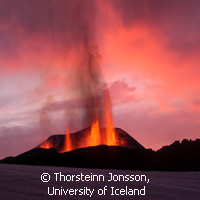Tick tock, tick tock... a volcano's about to erupt
Slumbering volcanoes keep scientists on their toes, as questions about if and when they will erupt never cease. Eyjafjallajökull, the Icelandic volcano that threw European aviation into a tailspin last spring, is a prime example of how volcanologists were aware that something was brewing inside the mountain that had lain dormant for two centuries. New research suggests that the culprit responsible for waking Eyjafjallajökull from its sleep was the magma flowing beneath it. Writing in the journal Nature, the volcanologists from Iceland, the Netherlands, Sweden and the US say: 'The eruptions are the culmination of 18 years of intermittent volcanic unrest.' Using seismic monitoring and GPS (global positioning system) data, as well as satellite, radar and surface measurements, they assessed geophysical changes in Eyjafjallajökull, particularly as the volcano's edifice began to deform. According to the team, the volcano ballooned for almost three months before it started to erupt in March from one flank. 'Several months of unrest preceded the eruptions, with magma moving around downstairs in the plumbing and making noise in the form of earthquakes,' explains Professor Kurt Feigl from the University of Wisconsin-Madison in the US. 'By monitoring volcanoes, we can understand the processes that drive them to erupt. If you watch a volcano for decades, you can tell when it's getting restless.' Led by Dr Freysteinn Sigmundsson from the Nordic Volcanological Centre at the University of Iceland, the team began a vigilant watch on the mountain in late summer 2009 after a subtle shift emerged at a GSP station on Eyjafjallajökull's flank. By early 2010, the researchers noted a hike in the rate of deformation and the number of earthquakes. As the deformation and shocks failed to abate, the scientists installed more GPS stations near the mountain. Flash-forward a few weeks, and more rapid inflation surfaced. The researchers understood that magma was moving upwards through the 'plumbing' inside the volcano. When Eyjafjallajökull started to erupt in late March, its flanks had swelled by more than around 15 centimetres as magma flowed from deep within the Earth into shallow chambers underneath the mountain, according to the researchers. Once the eruption began, the deformation ceased. But Eyjafjallajökull differed in that instead of deflating as the magma flowed - which is the norm for volcanoes - it remained inflated until mid April, when the first eruption ended. 'The deformation associated with the eruptions was unusual because it did not relate to pressure changes within a single magma chamber,' the authors write. 'Deformation was rapid before the first eruption, but negligible during it. Lack of distinct co-eruptive deflation indicates that the net volume of magma drained from shallow depth during this eruption was small; rather, magma flowed from considerable depth.' The volcano erupted again on April 22, and the lava flowed through a new conduit under the ice on the summit of the mountain. The result? Water flashed to steam and gas escaped from bubbles in the magma, creating an 'ash plume' that climbed high up in the sky and triggering huge headaches for all travellers across Europe. While the results helped shed light on the Icelandic phenomenon, the researchers say more testing is needed to determine why volcanoes erupt when they do because questions remain over the geological processes that kick-start an actual eruption. 'We're still trying to figure out what wakes up a volcano,' Professor Feigl says. 'The explosiveness of the eruption depends on the type of magma, and the type of magma depends on the depth of its source. We're a long way from being able to predict eruptions, but if we can visualise the magma as it moves upward inside the volcano, then we'll improve our understanding of the processes driving volcanic activity.'
Countries
Iceland, Netherlands, Sweden, United States



